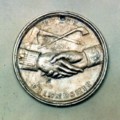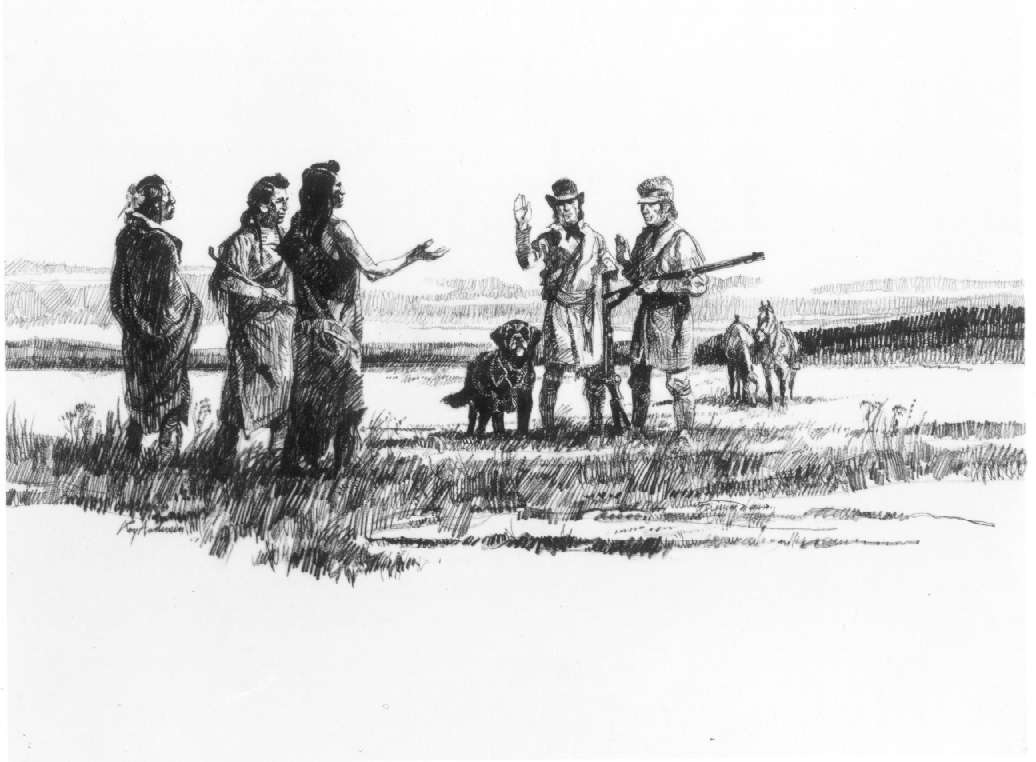A 1954 American view of the "wilderness," from the Encyclopedia Britannica Film, "Lewis and Clark"
"Lewis and Clark," the 17-minute 1954 Encyclopedia Britannica Film
A Lewis and Clark Perspective
After the difficult crossing over the Bitterroot Mountains, the Corps of Discovery had left the territory of the United States, lands acquired in 1803 as part of the Louisiana Purchase. They were now journeying into territory Britain claimed as part of Canada (until a treaty with the United States in 1846 established the 49th parallel as the boundary separating Canada and the United States). In addition to Britian, Lewis and Clark would soon discover that these were lands that were claimed by other peoples as well, since time immemorial.
What would await the Corps of Discovery? What sort of relations would be sought and negotiated by Lewis and Clark with those they would encounter? Who holds the strongest claim to these lands?
On September 20th 1805, William Clark wrote in his journal:
I set out early . . . proceeded on through a butifull Country for three miles to a Small Plain in which I found maney Indian lodges, at the distance of 1 mile from the lodges I met 3 boys, when they Saw me ran and hid themselves in the grass I dismounted gave my gun & horse to one of the men, searched in the grass and found 2 of the boys gave them Small pieces of ribin & Sent them forward to the village. Soon after a man Came out to meet me with great Caution and Conducted us to a large Spacious Lodge which he told me (by signs) was a Lodge of his great Chief who had Set out 3 days previous with all the Warriers of the nation to war on a South West derection & would return in 15 or 18 days. the fiew men that were left in the Village aged, great numbers of women gathered around me with much apparent Signs of fear, and apr. pleased they (those people) gave us a Small piece of Buffalow meat, Some dried Salmon berries & roots in different States, Some round and much like an onion which they call (Pas she co) quamash the bread or cake is called Pas-she-co Sweet, of this they make bread and Supe. they also gave us the bread made of this root all of which we eate hartily, I gave them a few small articles as presents, and proceeded on with a Chief to his Village 2 miles in the Same Plain, we were treated kindly in their way and continued with them all night. Those two Villages consist of about 30 double lodges, but few men a number of women & children; They call themselves Cho pun-nish or Perced Noses . . .
Map-
Lewis and Clark 1806
Biographies-
Broken Arm
- Twisted Hair
Web Links The following sites offer great information on the Nez Perce (Nee-Me-Poo) Trail, the Conflict of 1877, and the Lewis and Clark expedition, along with event calendars, maps and other useful materials.
- Nez Perce (Nee-Me-Poo) National Historic Trail
- Nez Perce National Historical Park
|
|
|
Mylie Lawyer tells of the initial contact with the Corps of Discovery and subsequent assistance provided by the Nimíipuu. (Interviewed by Ann McCormeck and Josiah Pinkham in Feburary 2002) |
While there had been initial discussion on whether to attack or assist the Corps of Discovery, the Nimíipuu ultimately extended their hands in friendship to Lewis and Clark. In Twisted Hair's village, the men of the Corps of Discovery were given lodging and fed "buffalo meat, some tried salmon berries and roots in different states," made into a "bread and soup." And they "ate heartily." The Nimíipuu helped Lewis and Clark prepare maps for their journey ahead, showed them how to fashion canoes, accompanied them as guides on their journey down river, and cared for their horses until they returned the following spring. Upon their return in May of 1806, the Corps was again treated with friendship by Broken Arm and the Nimíipuu, as Lewis and Clark awaited their crossing over the Bitterroots. They settled in at Camp Chopunnish, along the Clearwater River near the Heart of the Monster. The Nimíipuu thus provided Lewis and Clark much needed hospitality, allowing the men of the Corps of Discovery to rest after their difficult journeys over the Bitterroot Mountains in 1805 and upon returning up the Columbia River in 1806.

| Jefferson
Peace Medal
|
In exchange for their assistance, the Nimíipuu received colored ribbons and Jefferson Peace Medals, the medical expertise of William Clark and reference to a powerful "black book" (the Christian Bible), and an anticipated trading relationship with the soyaapos. It would be a trading relationship in which various metal tools, such as knives, pots and the rifle, and fine glass beads to fashion into rich decorative patterns to adorn their clothing, would be acquired. The ancient prophecies of the coming of the soyaapos were being realized. And something else would be forth coming and soon "acquired."
While their relations with Lewis and Clark and the men of the Corps of Discovery was most amicable and promised future benefit for the Nimíipuu, their meeting on the camas fields of Weippe prairie on September 20th 1805 would also signal for the Nimíipuu the beginning of an unprecedented onslaught of events that would challenge the very foundations of their way of life.
|
Silas Whitman offers his perspective on the impact of the Corps of Discovery on the Nimíipuu. (Interviewed by Josiah Pinkham in January 2002) |
With the coming of the soyaapos to Indian country, the "acquisitions" included the ravages of smallpox and other epidemic diseases would take an immense toll in loss of life, felt as early as the 1780s and continuing through the nineteenth century. In 1811 the first fur traders began settling along the Clearwater River, seeking out their fortune, and soon were replaced by an even greater number of gold seekers.
In 1833, missionaries would begin preaching and coercing to "save souls," and bringing with them disillusionment and factionalism that would rip families apart, pitting brother against brother, and undermining traditional ways.
Governors and Superintendents of Indian Affairs would, in rather heavy-handed fashion, establish "treaties of peace" in 1855 and 1863. And with these treaties came a curtailing of a people's once unobstructed travel in alignment with the changing seasons. And with the creation of these "reserved lands" or reservations would also come the conflict of 1877 and then defeat, and an undermining of a people's sovereignty. In the 1890s, an allotment act would be unilaterally imposed onto the Nimíipuu, further eroding a land-base so essential to the people.
|
|
Beatrice Miles reflects on the significance of Lewis and Clark for the Nimíipuu. (Interviewed by Josiah Pinkham in December 2001) |
While hands of friendship were extended, U.S. Army officers Meriwether Lewis and William Clark have brought a "face" to a potentially devastating set of events, symbolizing much of the ambivalence, as well as threat soyaapo "civilization" would come to mean to the Nimíipuu. While benefits from the new soyaapo relationship are acknowledged, "discovery" has also come to mean loss of human life, loss of access to land and water, loss of wildlife habitat and endangerment of the salmon, and loss of cultural ways.

| On the Weippe Drawing by Roy Anderson, 1983
|
Nevertheless, the story of the Nimíipuu people is ultimately one of continuity and adaptation, and triumph and vitality in the face of adversity. While the threat to the foundations of the Nimíipuu way of life has been nothing less than catastrophic, the Nimíipuu have been able to apply the wisdom of their ancestors, and integrate it with the best knowledge offered by the soyaapo way of life. In the construction and operation of their new fish hatchery, the Nimíipuu fisheries program has embraced scientific fish biology along side traditional teachings. Inspired by the ancient designs worn by his grandmother or the oral traditions she still tells, an artist incorporates those images onto canvas with oil paints and brushes or onto the stage with costumes and actors. The warriors of today no longer fight with rifles, trained in military tactics, but are armed with political strategy and law degrees, firing off elegant words argued before judges and governors. As the horse was successful embraced into the Nimíipuu family, so the "face" brought by Lewis and Clark has also come to mean new opportunities and ways of addressing the many challenges we all face entering the 21st Century.
© Nez Perce Tribe 2002
next >
|
|
|




 28K 56K 256K
28K 56K 256K

 256K
256K





